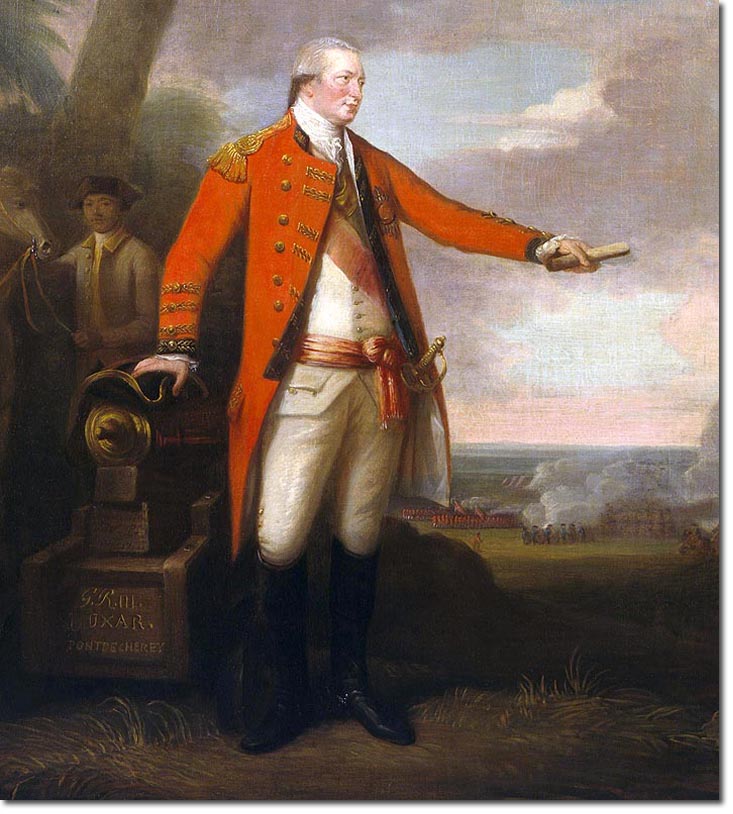|
|


|
|
Hector Munro was born in 1726, the son of Hugh Munro of Novar, in Ross, Scotland, he was commissioned into Loudon's Highlanders in 1747. Hector then had a Lieutenant's commission in the 34th Regiment of Foot. On the regiment's disbandment in 1749 he transferred to the 48th Foot. In 1754 Munro transferred to the 31st Foot as a lieutenant. Also in 1754, he was ordered to Badenoch with three squadrons of Dragoons to apprehend certain rebels in that district, with special instructions to apprehend John Dubh Cameron, better known as "Sergent Mor". Munro successfully captured the sergeant after he was betrayed by a local farmer. John Cameron was soon afterwards executed in Perth.
He was also tasked with capturing Cluny Macpherson, who took part in the Jacobite rising of 1745 to 1746. However Macpherson evaded Munro's grasp and escaped to France. It is said that Munro turned a blind eye and allowed Macpherson to escape as he was a friend. In 1756 Munro was promoted captain in the new 2nd Battalion, which became the 70th Foot in 1758. In 1759 he was appointed major in the newly raised 89th (Highland) Regiment of Foot. The regiment embarked at Portsmouth for the East Indies in December 1760, and arrived at Bombay in November following. The 89th had no particular station assigned to it, but kept moving from place to place until a strong detachment under Major Hector Munro joined the army under the command of Major Carnac, in the neighbourhood of Patna. Major Munro then assumed the command, and being well supported by his men, quelled a formidable mutiny among the troops. Twenty Sepoys had been executed by Major Munro by blowing them off guns, and with discipline restored, he attacked the enemy at Buxar, on 23 October 1764 in what became the Battle of Buxar. Though the force opposed to him was five times as numerous as his own, he overthrew and dispersed it. The enemy had 6000 men killed, and left 130 pieces of cannon on the field, whilst his majesty's troops had only 2 officers and 4 rank and file killed. Returning home, he was elected, in 1768, as member of parliament for the Inverness Burghs, which he continued to represent for over thirty years, though much of this period was spent in India, where he returned in 1778 to take command of the Madras Army. Later in 1778 Munro took Pondichery from the French, but in 1780 in the Second Anglo-Mysore War he was defeated by Hyder Ali at Perambakam near Conjeeveram, and forced to fall back on St. Thomas Mount. There Sir Eyre Coote took command of the army, and in 1781 won a major victory against Hyder Ali at Porto Novo (Parangipettai), where Munro was in command of the right division. Negapatam was taken by Munro in November of the same year; and in 1782 he retired to Scotland. In June 1787 he was made Colonel of the 42nd Highland Regiment (Black Watch) and held the post for 18 years, until his death on 27 Dec 1805. The portrait shows him in India, painted by David Martin. According to Forbes's history he was not an attentive Colonel to the Black Watch: 'In the end of 1805 Sir Hector Munro died. A fine soldier, he did not interest himself greatly in the regiment, of which he had been colonel since 1787, nor did he seem to regard it with the concern and feeling which might have been expected on the part of a fellow-countryman and a fellow-Highlander who with an affluent fortune and the influence which it commanded, might have materially contributed to the welfare and furtherance of the Black Watch. Although the first and second battalions of his regiment were for a considerable time quartered at Fort George in the neighbourhood of his country seat, he never came near them except once, when he stopped in the garrison for a few minutes to change horses on his way to London.' |
Armed Forces | Art and Culture | Articles | Biographies | Colonies | Discussion | Glossary | Home | Library | Links | Map Room | Sources and Media | Science and Technology | Search | Student Zone | Timelines | TV & Film | Wargames